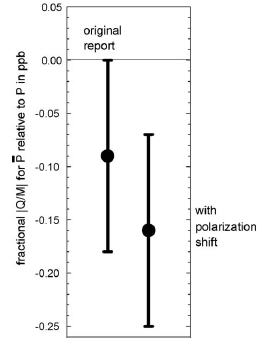Our series of three measurements of the charge-to-mass ratio of the antiproton, Q/M, improved the state of the art by nearly a factor of a million. The last of the three measurements stands as the most stringent test of CPT invariance made with a baryon system by a very large factor.
 |
 |
The cyclotron frequency of the center-of-mass motion of about 100 antiprotons was compared to that of about 100 protons to make a Q/M comparison with an accuracy of 40 ppb = 4 x 10-8. Phys. Rev. Lett. (1990). |
 |
The cyclotron frequency of one trapped antiproton was compared to that of one proton trapped at a slightly different time to make a Q/M comparison with an accuracy of 1 ppb = 1 x 10-9. Phys. Rev. Lett. (1995). |
 |
The cyclotron frequencies of a simultaneously trapped antiproton and negative hydrogen ions were compared. The systematic errors were greatly reduced because both had the same sign of charge and because no particles had to be loaded during the measurement. Measurements were made on the centered particle, with the other "parked" in a cyclotron orbit large enough to avoid disturbing the measurement. The position of the two particles was then switched. The Q/M for the antiproton and proton was compared to 90 ppt = 9 x 10-11. Phys. Rev. Lett. (1999). |
|
A short review focuses upon the mass measurements, and slightly shifts the result (well within its error bars) to account for a small polarization shift (figure right) that did not extrapolate away with decreasing cyclotron energy. A more detailed review discusses the methods that we developed to slow, trap and cool antiprotons. At the current level of measurement accuracy there is no evidence that the antiproton and proton have charge-to-mass ratios that differ in magnitude. |

|
We are not currently pursuing a better comparison of Q/M for the antiproton and proton. However, just before LEAR shut down we demonstrated that a more accurate measurement was possible.
© 2015 - Last Updated: 08/30/2018 - Disclaimer